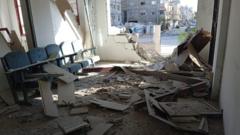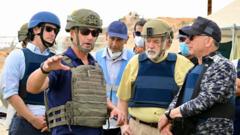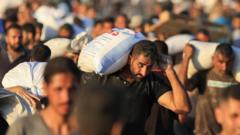Following intense warfare and destruction, the Gaza Strip has experienced a staggering transformation, impacting its population's livelihoods, infrastructure, and economy. The visual data reveals the grim realities faced by Gazans, revealing a path to potential recovery that could take decades.
Transformation of Gaza: A Visual Chronicle of War's Aftermath

Transformation of Gaza: A Visual Chronicle of War's Aftermath
The ongoing conflict in Gaza has led to severe devastation affecting millions, reshaping the territory and its living conditions over the past 15 months.
In the Gaza Strip, a ceasefire agreement has been established after 15 harrowing months of conflict. The recent fighting emerged after a large-scale assault by Hamas on October 7, 2023, which resulted in approximately 1,200 deaths and widespread hostage situations. In retaliation, an extensive bombing campaign and ground invasion by Israel aimed to dismantle Hamas's military capabilities—a group that has wielded power in Gaza since 2007. Tragically, more than 46,600 Palestinian lives have been lost as a result of these hostilities, according to the Gaza health ministry figures.
While hopes of lasting peace linger with the ceasefire, the United Nations warns that recovery for the devastated territory may span years, if not decades. Detailed visual analyses demonstrate the extent of the destruction wrought by the conflict. Israel's military operations commenced in northern Gaza, leading to significant damage in towns such as Beit Hanoun, which is located a mere 2 kilometers from the border. The bombings progressed southward, ultimately resulting in damage to both the northern and southern regions of Gaza. Experts estimate that around 60% of Gaza's buildings have been impacted by the conflict, with Gaza City witnessing the brunt of the destruction.
The ongoing humanitarian crisis has only been exacerbated by decades of blockade that preceded the war. With only 41 kilometers in length and 10 kilometers wide, Gaza struggles to be habitable as entire neighborhoods have been leveled, and agricultural lands have been decimated. The displacement of nearly the entire population—from 2.2 million—has resulted in overcrowded tent cities emerging in designated "humanitarian zones." Satellite imagery highlights these tent cities in al-Mawasi, near the Egyptian border, where the UN estimates over 1.2 million individuals are currently crammed into austere conditions lacking essential services.
Food insecurity is rampant, with nearly 1.8 million individuals in dire need. Figures reveal that the rates of acute malnutrition have skyrocketed, with 80% of the population historically dependent on humanitarian assistance. Aid deliveries have been severely restricted, leading to intensified suffering among the displaced. Concurrently, the economy of Gaza has suffered catastrophic damage, with the World Bank citing an extraordinary contraction of 86% in the first quarter of 2024.
Additionally, healthcare systems are faltering as hospitals face funding shortages and physical damage due to military incursions. The UN estimates that only half of Gaza’s medical facilities remain operational, while the rest are either damaged or completely destroyed. Environmental conditions have spiraled downward, with significant waste buildup and defunct water systems exacerbating already bleak living conditions.
As Gaza seeks to navigate this profound devastation, the UN Environmental Programme has cautioned that removal of debris alone could extend over two decades, underscoring the complex and multifaceted path to recovery for the residents of the war-torn region. Those impacted by these events are encouraged to recount their experiences and reach out, ensuring their voices are heard amid the devastation.
While hopes of lasting peace linger with the ceasefire, the United Nations warns that recovery for the devastated territory may span years, if not decades. Detailed visual analyses demonstrate the extent of the destruction wrought by the conflict. Israel's military operations commenced in northern Gaza, leading to significant damage in towns such as Beit Hanoun, which is located a mere 2 kilometers from the border. The bombings progressed southward, ultimately resulting in damage to both the northern and southern regions of Gaza. Experts estimate that around 60% of Gaza's buildings have been impacted by the conflict, with Gaza City witnessing the brunt of the destruction.
The ongoing humanitarian crisis has only been exacerbated by decades of blockade that preceded the war. With only 41 kilometers in length and 10 kilometers wide, Gaza struggles to be habitable as entire neighborhoods have been leveled, and agricultural lands have been decimated. The displacement of nearly the entire population—from 2.2 million—has resulted in overcrowded tent cities emerging in designated "humanitarian zones." Satellite imagery highlights these tent cities in al-Mawasi, near the Egyptian border, where the UN estimates over 1.2 million individuals are currently crammed into austere conditions lacking essential services.
Food insecurity is rampant, with nearly 1.8 million individuals in dire need. Figures reveal that the rates of acute malnutrition have skyrocketed, with 80% of the population historically dependent on humanitarian assistance. Aid deliveries have been severely restricted, leading to intensified suffering among the displaced. Concurrently, the economy of Gaza has suffered catastrophic damage, with the World Bank citing an extraordinary contraction of 86% in the first quarter of 2024.
Additionally, healthcare systems are faltering as hospitals face funding shortages and physical damage due to military incursions. The UN estimates that only half of Gaza’s medical facilities remain operational, while the rest are either damaged or completely destroyed. Environmental conditions have spiraled downward, with significant waste buildup and defunct water systems exacerbating already bleak living conditions.
As Gaza seeks to navigate this profound devastation, the UN Environmental Programme has cautioned that removal of debris alone could extend over two decades, underscoring the complex and multifaceted path to recovery for the residents of the war-torn region. Those impacted by these events are encouraged to recount their experiences and reach out, ensuring their voices are heard amid the devastation.




















